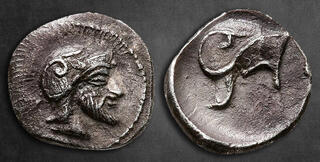Lot description:
Sicily. Himera circa 470-450 BC.
Litra AR
10 mm, 0,61 g
Bearded male head to right, wearing a crested Attic helmet, adorned with an olive sprig on the bowl / Attic helmet to right, adorned with a tendril on the bowl.
Attractive, toned and well-struck and centred. Near Extremely Fine.
Buceti 43b. HGC 2, 446. SNG Lloyd 1029.
The ancient city of Himera, located on the northern coast of Sicily, was one of the significant Greek colonies in the region, founded around 648 BC by settlers from Chalcis in Euboea and Zancle (modern Messina). It was strategically situated at the mouth of the Himera River, serving as a vital link between the Greek world and the indigenous populations of Sicily. Himera played a critical role in the Greek-Punic conflicts, standing as a bulwark against Carthaginian expansion in Sicily.
The coinage of Himera, like the one described – a Litra dating from circa 470-450 BC – offers a fascinating glimpse into the art, culture, and political affiliations of the city. The litra, made of silver, reflects the economic prosperity and trade connections of Himera. Its weight and composition align with the broader system of Greek coinage, which facilitated commerce across the Mediterranean.
The obverse of the coin features a bearded male head, right-facing, adorned with a crested Attic helmet. This imagery is significant in several ways. The helmet is a symbol of warfare and defense, possibly reflecting Himera's military readiness or its participation in the wider conflicts of the Greek world. The olive sprig on the helmet may symbolize peace or victory, potentially commemorating a specific event or general prosperity. The depiction of the bearded male could represent a god, hero, or local ruler, indicating the city's cultural and religious affiliations.
The reverse of the coin depicts an Attic helmet to the right, this time adorned with a tendril. This imagery reinforces the martial theme while also connecting to the agricultural bounty of Sicily, perhaps symbolizing the intertwining of military strength and economic prosperity.
Coins like the one from Himera serve multiple purposes beyond mere economic transactions. They are instruments of propaganda, conveying messages about the city's wealth, power, and divine favor. They also act as pieces of portable art, showcasing the skill of Himeran engravers and the aesthetic values of the time.
This Litra from Himera is a testament to the city's historical significance, reflecting its economic activity, cultural connections, and political ambitions in the classical period. It encapsulates a moment in time when Himera was an active participant in the complex tapestry of ancient Sicilian history
Starting price: 500 EUR |  |